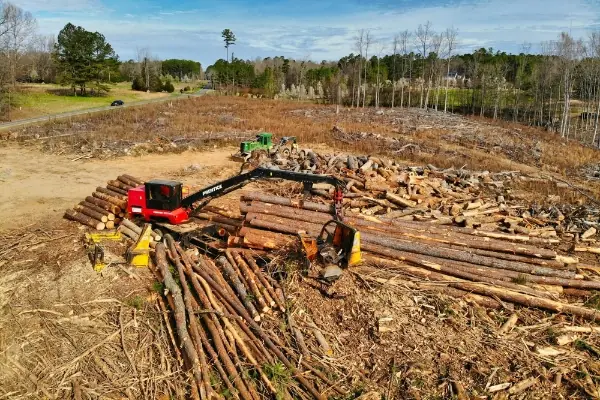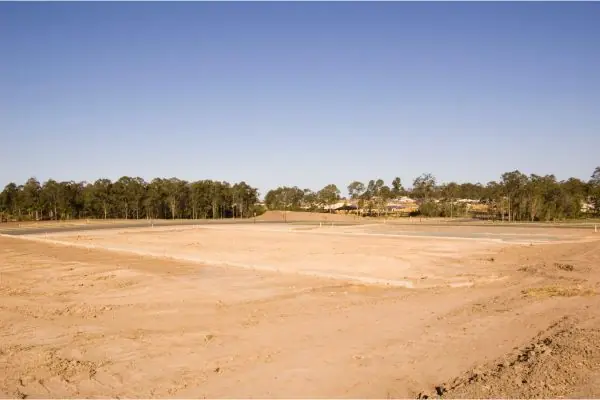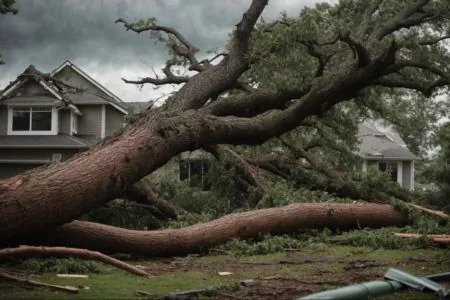Importance of Land Clearing
Clearing land is an essential step for new construction, landscaping, or farming, as it prepares the ground for its intended use. Many property owners often wonder, “How much does clearing land cost?” The cost can vary widely based on several factors, including the size of the area, terrain type, and the complexity of the work involved.
Additional elements like the presence of large trees, thick brush, or rocky soil can also influence the overall expense. Understanding these variables can help property owners budget and make informed decisions about land clearing. Let’s take a closer look at what land clearing is, why it matters, and what to consider before clearing land!
I. Average Cost to Get Land Cleared

Clearing land is critical in making a property accessible for future projects. The scope of land clearing can vary, as it often involves removing trees, shrubs, and sometimes even water features that may be obstacles. According to Forbes.com, it can range between $100 and $11,800, with most people spending around $3,100 on average. The process paves the way for builders and gardeners to transform a raw piece of land into a site ready for development or landscaping.
The land size plays a pivotal role in determining the landscape clearing costs. For instance, working on a single acre runs up a bill distinct from tackling a larger plot, owing to the volume of materials and labor required. The presence of mature trees, water elements, and the desired final condition of the land can influence the final cost. They dictate the complexity and duration of the clearing process, which naturally adds to the overall costs involved.
Land clearing prepares a site for construction or the creation of a lawn and contributes to the property’s health. Removing overgrown vegetation and dead trees can reduce the fire risk. It creates a barrier against pests and improves water flow across the property. So, while asking how much does clearing land cost, the benefits ensure that it is an investment worth making for the longevity and usability of the land.
II. What Is Land Clearing?
Land clearing is a fundamental activity that transforms empty terrain into usable land. It removes various natural and man-made debris from trees, shrubs, boulders, rocks, and dense grass. This activity is not about making space. It is also about shaping the terrain to suit specific needs and preventing issues such as soil erosion or poor drainage.

Expert land clearing contractors employ specialized techniques to handle vegetation. Adherence to safety standards is crucial, mainly when clearing materials like asbestos. The main goal with all of this is to create a clean slate with optimized soil health, and water can flow unimpeded.
A. Definition of Land Clearing
Land clearing involves thoroughly removing trees, grinding stumps, and brush to pave the way for property development. In the process, operators may create mulch from the cleared vegetation. This can help control soil erosion that otherwise leads to flooding. Proper clearing is a safeguard that ensures a property’s readiness for the development and insurance policy stipulations.
B. Elements Removed During Land Clearing
Experts efficiently remove obstacles that hinder construction and affect home insurance policies, targeting dense brush hiding pests and excess vegetation disrupting soil nutrients. Post-clearing soil tests ensure compliance with agricultural or structural standards.
Removing trees involves heavy equipment like bulldozers for thorough clearance and land preparation. Shrubs add to underbrush thickness, challenging clearance efforts; machinery cuts through for site preparation.
Boulder removal is crucial for smooth construction, preventing foundational issues and ensuring budget planning.
Rocks are repurposed or cleared for garden layouts, utilizing bulldozers and excavators. Sloped land clearing considers terrain for safe feature placement like paths and driveways. Grass removal prevents soil erosion, crucial for stable foundations during road or yard development.
Related Post: MULCH VS. WOOD CHIPS
III. Land Clearing Cost Breakdown

Understanding the factors that influence the average cost to clear land is vital for property owners planning for development or enhancements. From preparing sites for future retaining walls to ensuring a stable foundation, the cost of clearing land must account for these diverse aspects to provide an accurate budget projection.
A. By Size of Land
In home improvement and land development, land clearing costs are influenced by parcel size. Larger properties necessitate heavy machinery like loaders for extensive clearing, vital for agriculture or other uses. Project scope consideration prevents unforeseen expenses, including proper disposal costs for hazardous materials.
Clearing property for building varies with forest density and grading needs. Trench digging and detailed work pose risks of unexpected expenses, highlighting the need for thorough project analysis and planning to manage costs effectively.
B. By Land Condition
Land conditions significantly impact costs and sustainability goals. In areas where stable foundations are crucial for construction and oil tank installations, intensive digging increases expenses. Early assessment of land challenges prevents budget overruns, ensuring long-term project stability and environmental responsibility.
Light clearing prepares for developments like concrete slabs or zoning compliance, often involving minimal obstruction removal and cost-effective terrain leveling with fill dirt. Consulting HomeAdvisor provides insights into costs and preparations for successful construction. Dense clearing, requiring expertise and heavy equipment like backhoes, is labor-intensive and costly, necessitating preparedness for equipment expenses and higher labor payments.
IV. Factors That Affect the Cost of Land Clearing
Examining the land clearing process reveals various factors influencing the cost. Negotiating rocky terrain and renting equipment impact the expense per square foot. Septic tank installation involves a significant investment. Each element, interlinked, plays a pivotal role in the fiscal fabric of land preparation.
A. Location and Obstacles
The terrain’s complexity and obstacles like large rocks or hazardous materials significantly affect land clearing costs. Tasks are often charged by the hour, with dense brush or hidden hazards slowing the process and requiring specific techniques. Environmentally friendly practices can also increase expenses due to specialized debris removal methods to protect ecosystems and ensure proper disposal.
B. Equipment Rental Costs
Renting essential land-clearing equipment can be costly. Renting heavy machinery like bulldozers or excavators can quickly escalate expenses, especially with pollution control measures. Securing the right equipment is vital for efficiency and preventing damage, particularly near existing structures.
C. Manual Clearing
Diverse soil types can harbor disease and influence the ability to clear the land, making manual clearing essential. Laborers might chop diseased trees or dig by hand to create ponds, with soil type dictating the task’s difficulty. Manual clearing allows precision work that machinery can’t match, protecting the remaining land and vegetation.
D. Excavation (Soil Type and Slope)
Excavation is crucial in land clearing, especially for specific structures. Soil type greatly influences excavation ease; clay-heavy ground is challenging, while sandy soil may shift unexpectedly. Land slope affects excavation strategy, with steep inclines requiring careful management to avoid soil slippage and impacting methods for uprooting trees or cacti and determining debris dumpster size.
E. Tree Removal
Tree removal is often the most visible and costly aspect of land clearing due to the need for specialized equipment and skilled labor. Factors like tree size, health, and proximity to structures determine the approach. Larger or diseased trees requiring more resources for safe removal.
F. Grading and Leveling
Grading and leveling land after clearing prevent water pooling and ensure a stable base for future structures. This phase shapes the land for optimal drainage and foundation support. It impacts project costs due to the precision needed.
G. Professional Labor Costs
Hiring skilled workers for land clearing is a significant expense. Skilled laborers’ experience reduces project time and ensures compliance with local regulations. This results in a well-executed job and prevents future issues from improper clearing.
H. Permit Costs
Securing the necessary permits is a critical part of the land clearing that directly influences the overall cost. The type of project and location dictates the permits required. Each potentially carries its fee and impacts the project’s budget.
I. Land Surveying
Land surveying is a crucial step in land clearing that can impact the overall cost. A precise survey outlines the boundaries and topography. It also identifies potential issues that affect clearing techniques and costs. By providing accurate data, a survey ensures that the clearing work proceeds without legal disputes or errors.
J. Debris/Junk Removal Costs
After land clearing, tackling the debris and junk that accumulates is a necessary final step that adds to the overall cost. Responsible disposal of vegetation, rocks, and other materials often requires hiring additional services. This includes dump trucks to transport waste to designated disposal sites, with varying fees.
V. Consider hiring professionals for extensive projects
For large-scale and intricate land clearing projects, enlisting professionals is a wise decision. Skilled teams bring expertise and equipment to tackle complex tasks efficiently and safely. Their knowledge can be invaluable, ensuring compliance with regulations and preventing costly mistakes.

Land clearing services guarantee a higher level of precision in the land clearing process. This can be particularly crucial where attention to detail can mean the difference between a project’s success or failure. Professional land clearers work to meet project specifications. They minimize disruptions and maximize land use potential.
Professional land clearing services can offer property owners peace of mind. They are equipped to handle unexpected challenges that may arise during clearing and have the experience to adapt quickly. By relying on experts, property owners safeguard the value and the future of their land investment.
Conclusion
Land clearing transforms undeveloped terrain into usable land, vital for construction and agriculture. It enhances property health and safety by mitigating fire hazards and pest barriers and improving water flow. Precisely shaping the land meets building and landscaping needs, preventing soil erosion. Land clearing is crucial for property development, ensuring long-term land usability despite investments. Contact Shore Tree Service to learn more and to get your personalized land clearing quote today!





